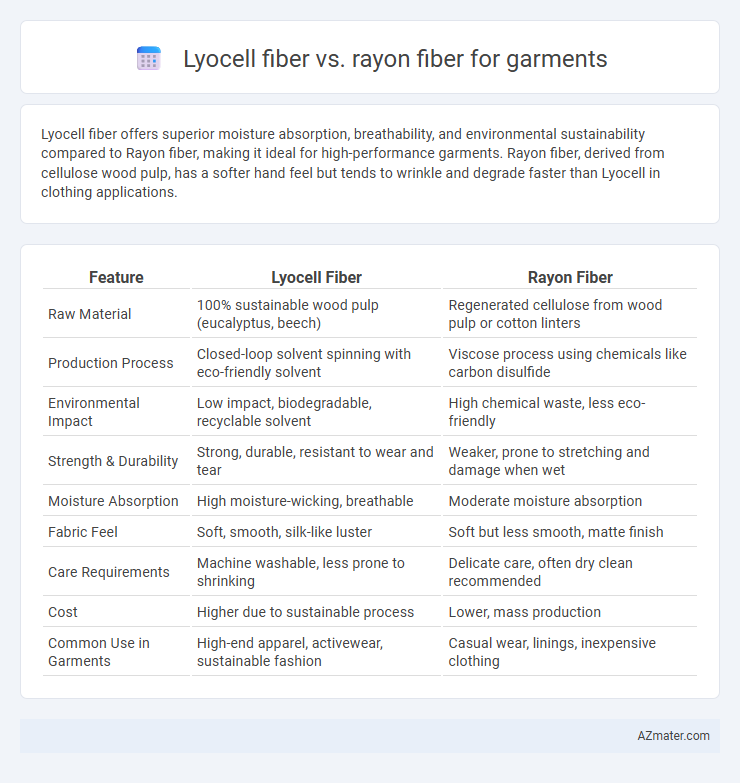Lyocell fiber offers superior moisture absorption, breathability, and environmental sustainability compared to Rayon fiber, making it ideal for high-performance garments. Rayon fiber, derived from cellulose wood pulp, has a softer hand feel but tends to wrinkle and degrade faster than Lyocell in clothing applications.
Table of Comparison
| Feature | Lyocell Fiber | Rayon Fiber |
|---|---|---|
| Raw Material | 100% sustainable wood pulp (eucalyptus, beech) | Regenerated cellulose from wood pulp or cotton linters |
| Production Process | Closed-loop solvent spinning with eco-friendly solvent | Viscose process using chemicals like carbon disulfide |
| Environmental Impact | Low impact, biodegradable, recyclable solvent | High chemical waste, less eco-friendly |
| Strength & Durability | Strong, durable, resistant to wear and tear | Weaker, prone to stretching and damage when wet |
| Moisture Absorption | High moisture-wicking, breathable | Moderate moisture absorption |
| Fabric Feel | Soft, smooth, silk-like luster | Soft but less smooth, matte finish |
| Care Requirements | Machine washable, less prone to shrinking | Delicate care, often dry clean recommended |
| Cost | Higher due to sustainable process | Lower, mass production |
| Common Use in Garments | High-end apparel, activewear, sustainable fashion | Casual wear, linings, inexpensive clothing |
Introduction to Lyocell and Rayon Fibers
Lyocell fiber is a sustainable, eco-friendly cellulose fiber produced through a closed-loop process using non-toxic solvents, prized for its softness, strength, and breathability in garments. Rayon fiber, a semi-synthetic cellulose fiber derived from wood pulp, offers versatility and affordability but involves more chemically intensive manufacturing methods compared to Lyocell. Both fibers are widely used in apparel for their moisture-wicking properties and smooth texture, yet Lyocell's environmental advantages and durability make it a preferred choice for sustainable fashion.
Production Processes: Lyocell vs. Rayon
Lyocell fiber production involves a closed-loop process using non-toxic solvents, where cellulose is dissolved in N-Methylmorpholine N-oxide, minimizing environmental impact and solvent waste. Rayon fiber manufacturing typically employs the viscose process, which uses carbon disulfide and produces significant chemical byproducts requiring extensive treatment to reduce pollution. Lyocell's eco-friendly solvent recovery contrasts with the viscose method's chemical intensity, making Lyocell a more sustainable option in garment fiber production.
Environmental Impact Comparison
Lyocell fiber, produced through a closed-loop process, significantly reduces water usage and chemical waste compared to conventional rayon, which relies on toxic solvents like carbon disulfide, contributing to environmental pollution. Lyocell's biodegradable properties and sustainable sourcing from fast-growing eucalyptus trees enhance its eco-friendliness, while rayon production often involves deforestation and higher energy consumption. The lower ecological footprint of Lyocell makes it a preferred choice for sustainable garment manufacturing aiming to minimize environmental impact.
Fiber Properties and Characteristics
Lyocell fiber offers superior moisture absorption and breathability compared to rayon, enhancing comfort in garments due to its smooth, silky texture and high tensile strength. Rayon fiber, derived from regenerated cellulose, tends to be less durable and more prone to shrinkage and wrinkling, but provides excellent dye affinity and softness. The eco-friendly solvent-spinning process used for lyocell results in biodegradable fibers with better resistance to wear and pilling, making it more suitable for sustainable fashion applications.
Comfort and Wearability in Garments
Lyocell fiber offers superior moisture-wicking and breathability compared to Rayon, enhancing comfort in garments especially in warm conditions. Its smooth surface reduces skin irritation and improves wearability by preventing chafing during prolonged use. Rayon, while soft and drapey, tends to absorb more moisture and dry slowly, which can lead to discomfort in humid environments or active wear.
Durability and Longevity of Fabrics
Lyocell fiber demonstrates superior durability compared to rayon fiber due to its stronger molecular structure and higher resistance to wear and tear, making garments last longer under frequent use and washing. Rayon tends to weaken when exposed to moisture repeatedly, leading to faster fabric degradation and reduced garment longevity. Choosing lyocell enhances fabric resilience, maintaining shape and texture over time, which is crucial for high-quality garment production focused on durability.
Dyeing and Color Retention
Lyocell fiber exhibits superior dye absorption and color retention compared to Rayon fiber due to its smooth and porous fiber structure, which allows deeper dye penetration and more uniform color distribution. The eco-friendly production process of Lyocell also results in fibers with fewer impurities, enhancing the vibrancy and longevity of dyed garments. In contrast, Rayon fibers, being semi-synthetic and highly absorbent, tend to show faster color fading and less resistance to repeated washing and exposure to sunlight.
Cost and Availability
Lyocell fiber typically costs more than rayon due to its eco-friendly closed-loop production process and higher manufacturing standards, which also limit its availability compared to the widely produced and more affordable rayon fiber. Rayon fibers, derived from regenerated cellulose, are extensively manufactured globally, making them more accessible for mass garment production with lower upfront costs. Manufacturers often choose rayon for budget-conscious projects, while lyocell is favored in premium or sustainable apparel markets despite its higher price point and relative scarcity.
Applications in the Fashion Industry
Lyocell fiber offers superior moisture-wicking and breathability compared to Rayon, making it ideal for activewear and sustainable fashion lines. Rayon, with its silky texture and vibrant dye affinity, remains popular for elegant dresses and linings in high-end garments. The fashion industry increasingly favors Lyocell for eco-friendly apparel due to its closed-loop production process, reducing environmental impact relative to Rayon's chemical-intensive manufacturing.
Choosing Between Lyocell and Rayon for Garment Manufacturing
Lyocell fiber offers superior moisture management, biodegradability, and strength compared to traditional rayon, making it a sustainable choice for garment manufacturing. Rayon, derived from cellulose as well, provides softness and drape but involves more chemically intensive processes, impacting environmental footprint. Choosing between lyocell and rayon depends on balancing eco-friendly production priorities with desired fabric qualities like texture, breathability, and durability for end-use garments.

Infographic: Lyocell fiber vs Rayon fiber for Garment
 azmater.com
azmater.com